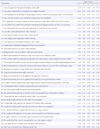Abstract
Purpose
The purpose of this study was to identify the patterns of physical restraint experience in mentally ill persons.
Methods
Q-methodology, an approach designed to discover patterns in various subjective experiences, was used. Twenty-two participants classified 36 selected Q-statements on a nine-point scale to create a normal distribution. The collected data were analyzed using the PC Quanl Program.
Results
Five types of physical restraint experience in mentally ill persons were identified by the participants. Type I Emotional reaction-explosive anger, Type II Emotional reaction-internalized anger, Type III Rational reaction-rejection, Type IV Rational reaction-acceptance, Type V Rational reaction-trust.
References
1. Bigwood S, Crowe M. It's part of the job, but it spoils the job: A phenomenological study of physical restraint. Int J Ment Health Nurs. 2008. 17:215–222.

2. Bonner G, Lowe T, Rawcliffe D, Wellman N. Trauma for all: A pilot study of the subjective experience of physical restraint for mental inpatient and staff in the UK. J Psychiatr Ment Health Nurs. 2002. 9:465–473.
3. Bower FL, McCullough CS, Timmons ME. A synthesis of what we know about the use of physical restraint and seclusion with patient in psychiatric setting: 2003 update. Online J Knowl Synth Nurs. 2003. 10:1.
4. Chae JH, Cha SJ, Hahm W, Lee KH, Lee JK. Different perceptions of the physical restraints between psychiatric inpatients and staffs in a mental hospital. J Korean Neuropsychiatr Assoc. 1996. 35:1145–1154.

5. Dye S, Brown S, Chhina N. Seclusion and restraint usage in seven English psychiatric intensive care units (PICUs). J Psychiatr Intensive Care. 2009. 5:69–79.

6. Fisher W. Restraint and seclusion: A review of the literature. Am J Psychiatry. 1994. 151:1584–1591.
7. Frueh BC, Knapp RG, Cusack KJ, Grubaugh AL, Sauvageot JA, Cousins VC, et al. Special section on seclusion and restraint: Patient reports of traumatic or harmful experiences within the psychiatric setting. Psychiatr Serv. 2005. 56:1123–1133.
8. Gallop R, McCay E, Guha M, Khan P. The experience of hospitalization and restraint of women who have history of childhood sexual abuse. Health Care Women Int. 1999. 20:401–416.

9. Hem E, Steen O, Opjordsmoen S. Thrombosis associated with physical restraint. Acta Psychiatr Scand. 2001. 103:73–75.

10. Hyun MH. A survey on human rights situation of psychiatric facilities. 2003. Seoul: National Human Rights Commission of Korea.
11. Ilkiw-Lavalle O, Grenyer BF. Differences between patient and staff perceptions of aggression in mental health units. Psychiatr Serv. 2003. 54:389–393.
12. Johnson ME. Being restrained: A study of power and powerfulness. Issues Ment Health Nurs. 1998. 19:191–206.
13. Johnson R, Beneda H. Reducing patient restraint use. Nurs Manage. 1998. 29:32–34.
14. Kim HK. Q methodology: Philosophy of science, theory, analysis, and application. 2008. Seoul: Communication Books.

15. Kim KS, Kim JH, Lee SH, Cha HK, Shin SJ, Chi SA. The physical restraint use in hospital nursing situation. J Korean Acad Nurs. 2000. 30:60–71.

16. Ministry of Health and Welfare. Mental health 65352-588: Seclusion and restraint guidelines. 2003. Seoul:

17. Park JH. Psychiatric nurse's perception in ethical situation. 2003. Seoul: Yonsei University;Unpublished master's thesis.

18. Ray N, Myers K, Rappaport M. Patient perspectives on restraint and seclusion experiences: A survey of former patients of New York state psychiatric facilities. Psychiatr Rehabil J. 1996. 20:11–18.
19. Scott TE, Gross JA. Brachial plexus injury due to vest restraints. N Engl J Med. 1989. 320:598.




 PDF
PDF ePub
ePub Citation
Citation Print
Print






 XML Download
XML Download